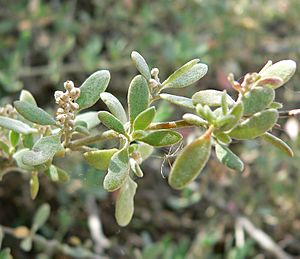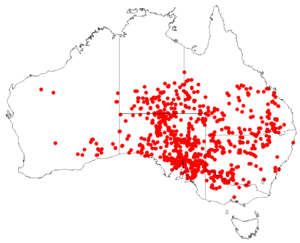Chenopodium spinescens facts for kids
Quick facts for kids Chenopodium spinescens |
|
|---|---|
| From Mueller (1889) | |
 |
|
| Foliage | |
| Conservation status | |
|
LC (TPWCA)
|
|
| Scientific classification | |
| Genus: |
Chenopodium
|
| Species: |
spinescens
|
 |
|
| Occurrence data from AVH | |
| Synonyms | |
|
|
Chenopodium spinescens (common names: spiny saltbush, berry saltbush, thorny saltbush, creeping saltbush, hedge saltbush) is a species of plant in the family Amaranthaceae, endemic to Australia. It is found in all states and territories of Australia with the exception of Tasmania.
Contents
Description
Chenopodium spinescens is a multi-stemmed dense shrub to 2 metres (7 ft) high, with branches often ending in spines. The leaves are alternate or opposite, and mealy, looking grey green to almost whitish from their covering of saucer-shaped/spherical hairs. The leaf shape is ovate to triangular, and are 5–17 millimetres (0.2–0.7 in) long and 5–17 millimetres (0.2–0.7 in) wide. The leaf petiole is about half the length of the lamina. Male and female flowers are usually on different plants. The flowers have five perianth segments that are tiny and all alike, and five stamens. The ripe fruit are red and succulent.
The inflorescence is a panicle or spike, with the flowers' perianth being densely mealy on the outside. The male flowers are globular and 0.5–1 mm in diameter, with their filaments united into a smooth saucer-shaped disc. The female flowers are larger (about 1 mm) and globular to top-shaped.
The fruit is a depressed globular pink or red succulent berry, and the seed is approximately 1 millimetre (0.04 in) in diameter with a reticulate coat. In the Northern Territory, it flowers and fruits from February to December, while in Victoria, it flowers from January to April.
Rhagodia spinescens differs from R. parabolica, in having smaller leaves (mostly 5-17 mm long, cf. mostly 15-30 mm long), a narrower inflorescence and a preference for non-rocky sites. It differs from R. eremaea in having leaves that are alternate or opposite (cf. consistently alternate), often spade-shaped, equal length and width or slightly longer than wide (cf. distinctly long relative to their width), with round saucer-like vesicles on the undersurface (cf. irregular-shaped vesicles) and have a fishy or foetid odour.
Taxonomy
Chenopodium spinescens was first formally described Robert Brown in 1810 as Rhagodia spinescens and the description was published in Prodromus Florae Novae Hollandiae et Insulae Van Diemen. In 2012, Susy Fuentes Bazán and Thomas Borsch moved all species of Rhagodia to Chenopodium within the broader family, Amaranthaceae. a change accepted by Govaerts, et al. However, the assignation of this plant to the genus, Rhagodia, and to the family, Chenopodiaceae, is the taxonomy accepted by the Council of Heads of Australasian Herbaria (CHAH),
Habitat
In the Northern Territory, it occurs on sandplains, alluvial plains, intermittent sandy watercourses, on sandy edges of salt lakes, and rarely on gravelly hillslopes. In Victoria, it is usually found on heavy, saline or subsaline soils at the edges of lakes, on flats, and in dune swales.
Distribution
It is found in the IBRA bioregions of Burt Plain, Central Ranges, Channel Country, Coolgardie, Finke, Flinders Lofty Block, Gawler, Great Sandy Desert, Great Victoria Desert, MacDonnell Ranges, Mitchell Grass Downs, Nullarbor, Riverina, Simpson Strzelecki Dunefields, Stony Plains, and Tanami. (Bioregions from Victoria, Queensland and New South Wales may not be included.)
Propagation
The advice for propagation is to take soft, current season growth tips from actively growing plants; store and transport wrapped in wet newspaper and sealed in a plastic bag, and plant after trimming cuttings to a length of 5–10 centimetres (2.0–3.9 in) and dipping in 3000 ppm IBA rooting hormone.

